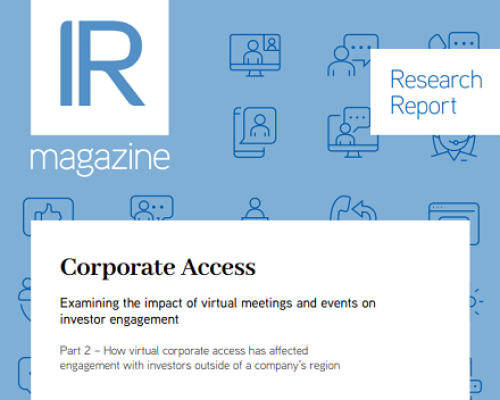In the second of two articles about video conferencing, Neil Stewart checks out desktop and mobile systems
As she reviewed some Asian stocks to invest in, Cynthia Tusan, a portfolio manager in Orange County, California, was thinking, ‘You can’t trust what you read, especially when it’s about emerging markets. You need to talk to the people on the ground.’ Out of the blue, she got a message from a start-up in Thailand called Capital Connections, offering to set up video conference meetings with companies of her choosing.
As president of Strategic Global Advisors, which has about $230 mn invested internationally, Tusan’s biggest challenge is getting a ‘real, first-hand heartbeat for what’s going on with foreign companies.’ The traditional way when she was running $1 bn in international equities for Wells Capital Management was to jump on a plane and go there. ‘But now, with the flow of information so quick, by the time you fly back, it’s old news,’ she says. ‘Travel makes sense to get the cultural feel of a country. But for simply talking to management, the technology is there.’
From high-end ‘immersive telepresence’ systems to low-cost desktop video conferencing, investors and companies have slowly begun replacing real meetings with virtual ones. The technology has been around for years, but now firms have the data bandwidth for higher-quality pictures and sound, their IT people are more comfortable with the security issues, and individuals have grown accustomed to using consumer products like Skype or FaceTime.
New paradigm
Capital Connections is an offshoot of Irideus.org, a group of independent research firms that do ‘intermediated’ equity research (paid-for research via stock exchanges). In the same way Irideus.org forged a new research model, Capital Connections is promoting a new corporate access paradigm. The concept is that company management members produce a presentation from a studio. Investors, sitting at their computers, can watch, listen and ask questions.
The difference between this and a normal webcast is the quality – Capital Connections’ meetings have high-definition video and clear audio – and interactivity (investors can talk to management in real time). Plus investors need an invitation to join in.
Shane Smith, founder and CEO of the group behind Irideus.org and Capital Connections, hopes to build studios around the world starting with one in Bangkok, which the group launched in March, followed by Hong Kong, Singapore, New York and Sydney. Mexico City and other Latin American cities are also in his sights.
The first and perhaps most obvious question is who pays. Smaller-cap issuers hungry for attention have to pay. ‘It’s important not to raise hurdles for the buy-side audience,’ Smith explains. ‘The key is to make it viable for it to connect with issuers smaller than it otherwise could connect with. The buy side’s investment is its time.’
But for larger, more liquid issuers, Capital Connections gets the buy side to pay – typically around $2,000 for a non-deal roadshow presentation including both a group session and a one-on-one. Smith says that works out to less than an institution would pay through commissions and logistics costs for a traditional live corporate access meeting.
Subscription model
Boston-based OpenExchange is taking a different approach to both the set-up and payment structure. It was started by finance industry veterans like Mark Loehr, who says he has cracked the problems of cost, quality and security by building OpenExchange’s calendaring system on the Vidyo conferencing platform.
By contrast to Capital Connections, with its studio-based set-up, OpenExchange allows meetings of all types and sizes, with participants at their desktop computers or laptops or using mobile devices, up to eight visible at a time. And while Capital Connections gets paid by the meeting, OpenExchange is subscription-based – $3 per day per user.
The company has angel backers, a new version of its software just released and contracts already being signed. It has gone from being tested by mid-tier sell-side companies to several bulge-bracket firms plus around 10 Fortune 100 companies, adding up to around 60 users – and growing.
Whereas a lot of companies don’t allow services like Skype across their firewalls, OpenExchange’s Vidyo platform appeases IT geeks and compliance officials with top-notch authentication. The other
big advance is that the video is scalable, so desktop users and mobile participants with slower connections can be in the same meeting, with the video signal adapting to their different bandwidths.
Loehr dispels any visions of a future where companies and investors are connected by technology without the involvement of the sell side. ‘I come from the sell side, so I have a bias, but I don’t believe the sell side is going to be disintermediated,’ he insists. ‘It has an important role filtering information and setting up meetings.’
The logic behind virtual meetings is simple. As Smith explains it, they convey the same non-verbal communication – body language, facial expressions, and so on – that come across in face-to-face meetings, but without the associated costs.
Many analysts, investors and IR professionals still say nothing can replace an eyeball-to-eyeball meeting. On the other hand, Tusan – and many like her – are already virtual meeting converts. She says using Capital Connections ‘is no different from having management members walk into our office and sit down with us. They may not look polished – but then I don’t want them to look polished.’
Going live
All that’s missing is a live tour of company facilities, but Tusan expects features like that to arrive soon. She believes investors like her will happily pay for virtual meetings, especially if they are located off the beaten path and get left off roadshow itineraries (she’s based far enough away from Los Angeles that many companies don’t make the trek).
Still, Tusan recognizes the challenge Capital Connections, OpenExchange and other firms like them face: they need a large pool of companies for investors and analysts to become interested, but they need a user base of investors and analysts to get companies on board.
Emerging markets companies in particular are hot beds for virtual meetings, Tusan concludes. ‘There’s a huge amount of interest in emerging markets,’ she points out. ‘And all those asset managers running that money want meetings with companies.’
How to look goodYou know the look, and it’s a look you don’t want: dark shadows, muddy sound, the camera peering up your nose. TJ Walker, chief executive of New York-based Media Training Worldwide, says the problem is not that Skype is low quality, but that people don’t use it correctly. If he can do TV interviews over Skype, why couldn’t it be used for virtual roadshows?Whether you’re using free video conferencing like Skype or FaceTime, or paying for a higher-end system like OpenExchange’s, there are easy ways to improve the quality of your presentation. Walker’s technical tips 1. Don’t sit with a window in the background. You need more light in front of you than behind you. 2. Elevate your webcam. If you’re using a laptop with a built-in camera, put it on a stack of books or a shoebox, so the camera is at eye level instead of at a low angle, which is creepy and unflattering. 3. Get a cheap $25 microphone and clip it to your lapel so you sound crisp and clear. 4. To jump to the next level, get a longer microphone cable, a $200-$300 high-definition video camera and a tripod. ‘Then you can actually stand, walk around and give a keynote speech,’ Walker says. 1. ‘Smile,’ Walker advises. ‘If you look bored, it’s certain you will be boring.’ 2. You need movement – your hands and/or your head. 3. ‘Reading is the absolute kiss of death,’ Walker adds. 4. Make-up for a virtual meeting? Don’t scoff. ‘You will look better with some powder so you aren’t shiny, or if you have a five o’clock shadow or dark circles under your eyes,’ Walker says. 5. Avoid plaid or striped clothes, which look distorted on internet video; white, which can cause ‘hot spots’; red, which ‘bleeds’ on camera; and black, because you can’t see where your body ends and your limbs start. A man might wear a blue suit, a light blue shirt and a solid tie, while a woman could try a solid-colored suit and a light-colored pastel shirt |
This article appeared in the October print edition of IR magazine.










